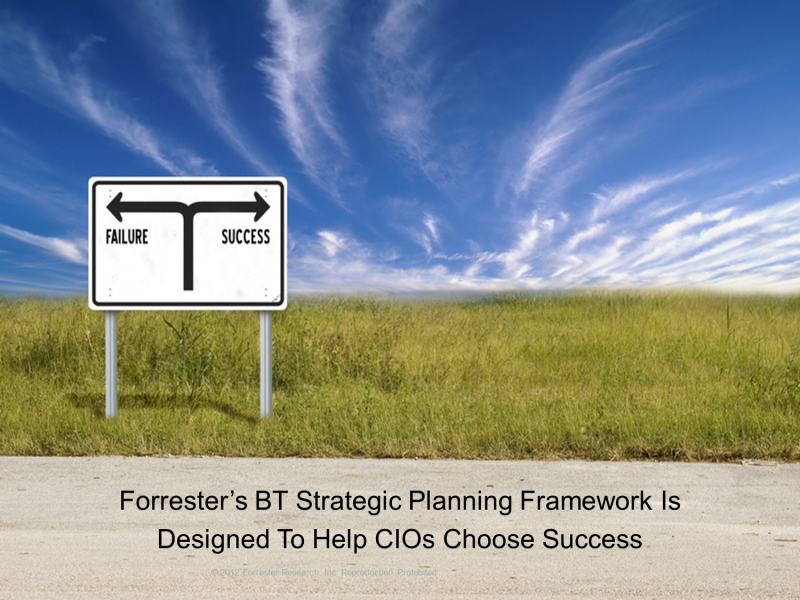Failure Is Not An Option
 As regular readers of my blog will know, I’ve been talking about moving beyond alignment for a number of years now. The fact is, too many CIOs have been able to get by on the basis of managing the technology black box — and CEOs and CFOs have been complicit in allowing these same CIOs the freedom to do what they want within tightly controlled budgets, not wanting to sully their hands with “all that technology stuff.” But those days are rapidly coming to an end. The technology genie is out of the bottle; today’s business-unit leaders are more dependent on technology than ever before, and they are also much more tech-savvy. CIOs can no longer hide behind the technology black box — it’s time to change the IT game forever. It’s time for IT to drive business results and connect all technology investments to business outcomes.
As regular readers of my blog will know, I’ve been talking about moving beyond alignment for a number of years now. The fact is, too many CIOs have been able to get by on the basis of managing the technology black box — and CEOs and CFOs have been complicit in allowing these same CIOs the freedom to do what they want within tightly controlled budgets, not wanting to sully their hands with “all that technology stuff.” But those days are rapidly coming to an end. The technology genie is out of the bottle; today’s business-unit leaders are more dependent on technology than ever before, and they are also much more tech-savvy. CIOs can no longer hide behind the technology black box — it’s time to change the IT game forever. It’s time for IT to drive business results and connect all technology investments to business outcomes.
Today’s new CEOs are looking to CIOs and IT to make a direct impact on business goals from investments in technology. While every business must make technology investments to sustain operations, IT must move beyond simply keeping the lights on and connect the dots between effective growth strategies and new technology investments. This requires a different set of technology and business skills: different people, process, and technology in the IT organization. In fact, the organization is so different we now call it the business technology organization, or BT. The distinction between IT and BT is subtle but important. BT represents the fusion of the IT organization into the rest of the business. In a BT organization, the lines between IT and business units are blurred. What is important is a focus on the roles needed for effective business technology strategy execution. What’s not important are reporting lines.
And for CIOs looking to remain successful for years to come, there is only really one effective decision ahead: "How do I shift my IT organization to become an effective business technology organization?" Failure to make this shift will be a career-ending decision for many CIOs.
The answer is not simple, if for no other reason than it must encompass all the facets of IT. But our research into BT organizations over the past six years shows that IT strategy formulation can become a cornerstone for moving toward BT — reshaping how the organization develops technology strategy. Traditional IT strategic planning efforts are suboptimal because they attempt to connect technology to business strategy as an afterthought. Our research shows that where technology strategy is an integral part of business strategy formulation, business executives increasingly see IT as a driver of business results and a source of innovation. By changing the way IT plans technology strategy, it’s possible for CIOs to begin to move from IT to BT.
To help CIOs drive this change throughout the organization, we’ve published a new strategy planning framework. This is a step-by-step approach to developing business strategy with a technology component or BT strategy (see figure). The framework begins with analysis of business and technology trends and shows how to take business goals and apply technology knowledge to help develop business strategy options based on the underlying technologies. The framework relies heavily on business capability maps as a driver of business technology discussions with business leaders.
- Plan strategy around 10 business trends
- Track tech trends that influence business strategies
- Assess you readiness to plan business technology strategies
- Beyond alignment: readiness assessment
- Begin strategic planning with clear business goals
- Use business capabilities to optimize BT strategy choices
- Create a living business technology strategic roadmap
In structuring the strategy framework, we’ve separated the CIO’s operating plan from the business technology strategy. The latter half of the framework addresses how to build an effective operating strategy in order to deliver on the BT strategy. Included in the framework is a self-assessment you can use to see how your organization compares today to the leading IT organization best practices unearthed in our research. By following the playbook outline, CIOs can begin the process of transformation for the IT organization and move toward BT and future success.
I’d love to hear your feedback on the framework and suggestions for how we can continue to refine it into the future.
Next post: BT Strategic Planning: Upcoming Events
Previous post: What Business Are You In?